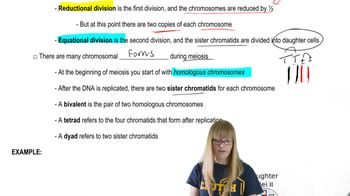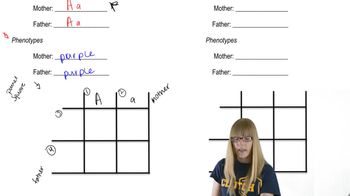Table of contents
- 1. Introduction to Genetics51m
- 2. Mendel's Laws of Inheritance3h 37m
- 3. Extensions to Mendelian Inheritance2h 41m
- 4. Genetic Mapping and Linkage2h 28m
- 5. Genetics of Bacteria and Viruses1h 21m
- 6. Chromosomal Variation1h 48m
- 7. DNA and Chromosome Structure56m
- 8. DNA Replication1h 10m
- 9. Mitosis and Meiosis1h 34m
- 10. Transcription1h 0m
- 11. Translation58m
- 12. Gene Regulation in Prokaryotes1h 19m
- 13. Gene Regulation in Eukaryotes44m
- 14. Genetic Control of Development44m
- 15. Genomes and Genomics1h 50m
- 16. Transposable Elements47m
- 17. Mutation, Repair, and Recombination1h 6m
- 18. Molecular Genetic Tools19m
- 19. Cancer Genetics29m
- 20. Quantitative Genetics1h 26m
- 21. Population Genetics50m
- 22. Evolutionary Genetics29m
2. Mendel's Laws of Inheritance
Monohybrid Cross
Problem 14
Textbook Question
You have isolated two petite mutants, pet1 and pet2, in Saccharomyces cerevisiae. When pet1 is mated with wild-type yeast, the haploid products following meiosis segregate 2:2 (wild type : petite). In contrast, when pet2 is mated with wild type, all haploid products following meiosis are wild type. To what class of petite mutations does each of these petite mutants belong? What types of progeny do you expect from a pet1 × pet2 mating?
 Verified step by step guidance
Verified step by step guidance1
Identify the type of petite mutation for pet1 based on the 2:2 segregation pattern when mated with wild-type. This suggests a nuclear mutation, as it follows Mendelian inheritance.
Identify the type of petite mutation for pet2 based on the observation that all progeny are wild type when mated with wild-type. This suggests a cytoplasmic mutation, as it is non-Mendelian and indicates a suppressive petite mutation.
Understand that nuclear mutations (like pet1) are typically recessive and follow Mendelian inheritance, while cytoplasmic mutations (like pet2) are often dominant and can suppress the petite phenotype.
Predict the outcome of a pet1 × pet2 mating. Since pet1 is a nuclear mutation and pet2 is a cytoplasmic mutation, the progeny will inherit the cytoplasmic elements from pet2, leading to all progeny being wild type due to the suppressive nature of pet2.
Conclude that the mating of pet1 and pet2 will result in all wild-type progeny, as the suppressive cytoplasmic mutation from pet2 overrides the nuclear mutation from pet1.
Recommended similar problem, with video answer:
 Verified Solution
Verified SolutionThis video solution was recommended by our tutors as helpful for the problem above
Video duration:
3mPlay a video:
Was this helpful?
Key Concepts
Here are the essential concepts you must grasp in order to answer the question correctly.
Mitochondrial Genetics
Mitochondrial genetics refers to the study of genes located in the mitochondria, which are inherited maternally. In yeast, petite mutations often arise from defects in mitochondrial DNA, affecting cellular respiration. Understanding this concept is crucial for distinguishing between nuclear and mitochondrial mutations, especially in the context of yeast mutants like pet1 and pet2.
Recommended video:
Guided course

Descriptive Genetics
Meiosis and Segregation
Meiosis is a type of cell division that reduces the chromosome number by half, resulting in four haploid cells. The segregation of alleles during meiosis can lead to different phenotypic ratios in the offspring. In the case of pet1, the 2:2 segregation indicates a nuclear mutation, while the uniform wild-type offspring from pet2 suggests a mitochondrial mutation, as mitochondrial traits do not segregate in the same manner.
Recommended video:
Guided course

Meiosis Overview
Complementation Testing
Complementation testing is a genetic technique used to determine whether two mutations are in the same gene or in different genes. By mating pet1 and pet2, we can assess whether the petite phenotypes can complement each other, which would indicate they are mutations in different genes. This is essential for predicting the progeny types from a pet1 × pet2 cross, as it helps clarify the genetic basis of the petite phenotype.
Recommended video:
Guided course

Complementation

 1:20m
1:20mWatch next
Master Monohybrid Cross with a bite sized video explanation from Kylia Goodner
Start learningRelated Videos
Related Practice


